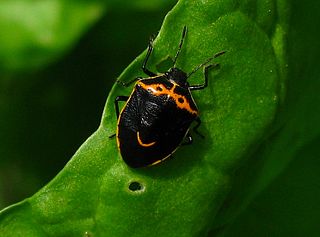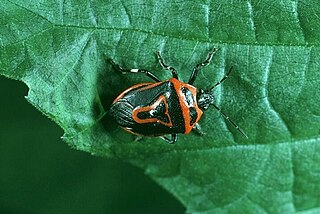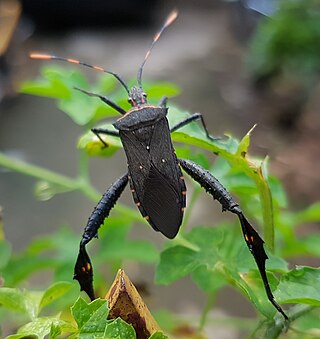
Pentatomidae is a family of insects belonging to the order Hemiptera, generally called shield bugs or stink bugs. Pentatomidae is the largest family in the superfamily Pentatomoidea, and contains around 900 genera and over 4700 species. As hemipterans, the pentatomids have piercing sucking mouthparts, and most are phytophagous, including several species which are severe pests on agricultural crops. However, some species, particularly in the subfamily Asopinae, are predatory and may be considered beneficial.

Asopinae are a subfamily of stink bugs. They are predatory stink bugs that are useful as biological control agents against pests, even against other Pentatomid species, which are all herbivorous.

Cosmopepla conspicillaris is a species of insect in the family Pentatomidae first described by William Dallas in 1851. Due to its common preference for plants in the genus Stachys, it is often called the hedgenettle stink bug. It is also known as the conspicuous stink bug, two-spotted stink bug or happy bespectacled stink bug depending on locality. The name two-spotted stink bug is better applied to another species, Perillus bioculatus.

Perillus bioculatus, the two-spotted stink bug or double-eyed soldier bug, is a species of insect in the family Pentatomidae. They are native to North America but have been introduced to Eastern Europe and North India. Both the larval and adult stages are specialized predators of eggs and larvae of the Colorado potato beetle. However, the first instar larvae feed by sucking the juices out of potato stems.

Perillus is a genus of predatory stink bugs in the family Pentatomidae. There are about seven described species in Perillus.

Perillus confluens is a species of predatory stink bugs in the family Pentatomidae. It is found in Central America and North America.

Perillus strigipes is a species of predatory stink bug in the family Pentatomidae. It is found in North America.

Anasa armigera, the horned squash bug, is a species of leaf-footed bug in the family Coreidae. It is found in North America.

Perillus circumcinctus is a species of predatory stink bug in the family Pentatomidae. It is found in North America.

Psallus is a genus of plant bugs in the family Miridae. There are more than 170 described species in Psallus.
Mixogaster breviventris is a species of syrphid fly in the family Syrphidae.
Chrysotoxum chinook is a species of syrphid fly in the family Syrphidae.
Aradus funestus is a species of flat bug in the family Aradidae. It is found in North America.
Pilophorus tibialis is a species of plant bug in the family Miridae. It is found in Central America and North America.
Aradus depictus is a species of flat bug in the family Aradidae. It is found in North America.

Cimolus is a genus of leaf-footed bugs in the family Coreidae. There are at least four described species in Cimolus.
Plagiognathus brunneus is a species of plant bug in the family Miridae. It is found in North America.
Plagiognathus albatus is a species of plant bug in the family Miridae. It is found in North America.
Perillus splendidus is a species of predatory stink bug in the family Pentatomidae. It is found in Central America and North America.

Leptoglossus gonagra, known as the passionvine bug, citron bug or squash bug in different parts of its range, is a species of leaf-footed bug in the family Coreidae. It is found in Africa, the Caribbean, Central America, North America, South America, Southern Asia, the Pacific Ocean and Oceania.











